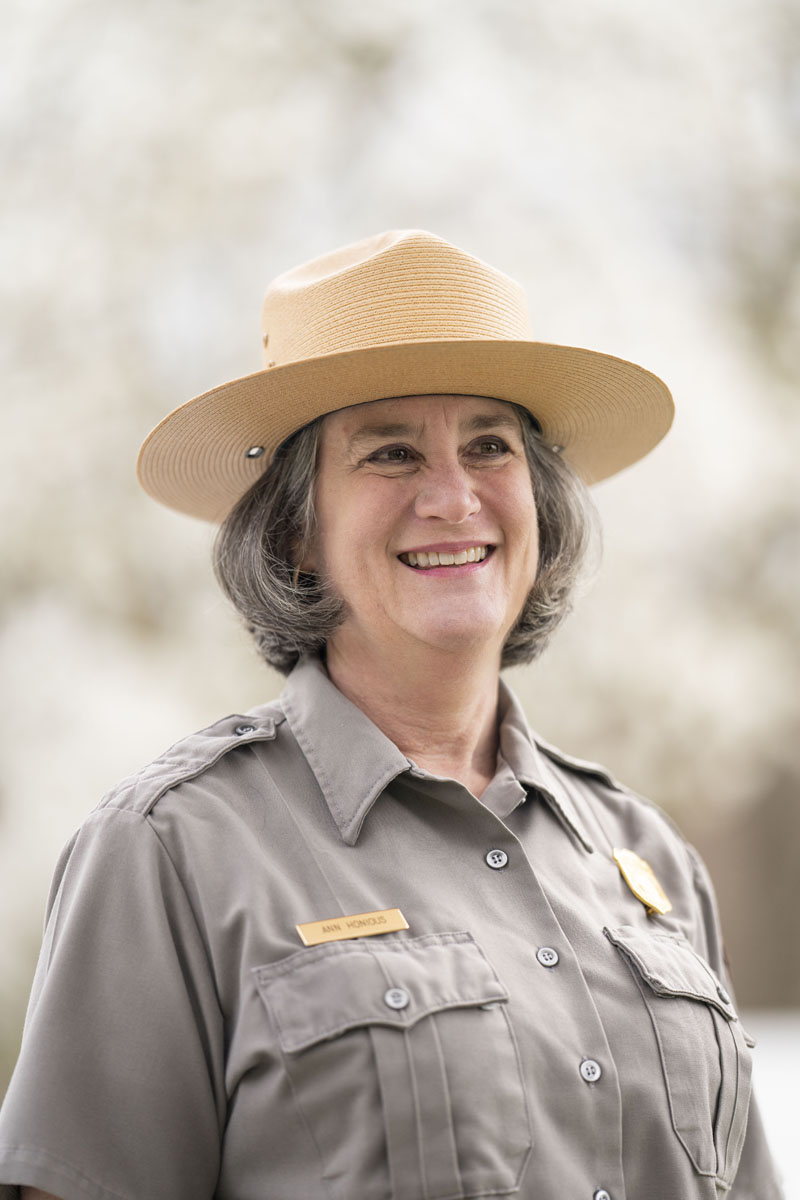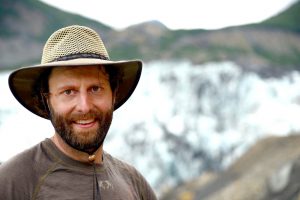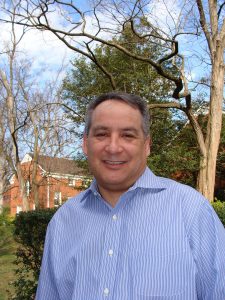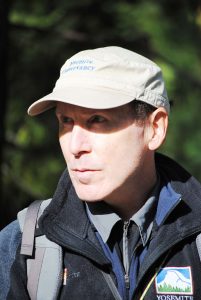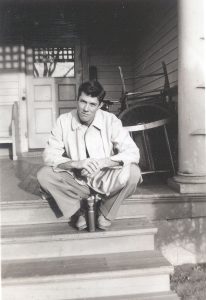CC Alumni Protecting and Preserving Our National Parks
If your picture of a National Park Service employee is a ranger with green pants, a gold badge, and a broad-brimmed, quad-dented flat hat guiding people through the wild outdoors, you wouldn’t be wrong. Assigned to 419 designated areas and more than 150 related areas across the country, many of the more than 20,000 permanent, temporary, and seasonal employees still greet visitors in this uniform. But park service properties go way beyond our natural heritage — as do the jobs (and clothing) of a handful of CC alumni we spoke with who steward our national park system.
Twenty-eight years ago, Ann Deines Honious ’87 (pictured above) began her employment with the park service as a historian for the National Capital Region in Washington, D.C. She spent two years surveying structures along the Chesapeake and Ohio Canal National Historical Park; documenting them, their locations, and the condition they were in; and conducting research to determine their eligibility for the National Register of Historic Places.
From there, she headed to Dayton, Ohio, to be the historian at the Dayton Aviation Heritage National Historical Park. “I was lucky in that it was a brand-new park. I was the second employee there,” she says. “I started two years after it was authorized by Congress and I got to experience the development and the creation of a national park.”
Honious also got to tackle a wider variety of tasks than is typical for a historian, from planning storytelling and exhibits to helping develop management documents.
“That evolved into an interest for sharing history with people and making it interesting to everyone so that they would want to learn about great things that happened in America,” she says. It also evolved into her first book, “What Dreams We Have: The Wright Brothers and Their Hometown of Dayton, Ohio,” which became a sales item to help promote the park.
Honious stayed put for 15 years in Dayton, unusual for park service staff, she says. “People tend to move a lot. Parks are small and if you want to do something different or move up the ladder, you often need to move to gain that experience.”
But then an opportunity did arise and she landed in St. Louis to be the chief of museum services and interpretation of what is now Gateway Arch National Park. It was another chance for her to create museum exhibits and a park that would interest people and foster their curiosity about history and America.
“When I got there, there was the beginning of an international design competition to redo the park, and the kickoff of a $380 million dollar public-private partnership. … I helped with the development and design of a new 55,000-square-foot museum that’s underneath the arch and then the redo of the building and how it would operate and be staffed.”
Five years ago, Honious moved once again, to take on the role of deputy superintendent at National Capital Parks-East, an administrative unit of parks that cover more than 8,000 acres and includes more than 90 sites within Washington, D.C., and Maryland, including the Frederick Douglass National Historic Site, Carter G. Woodson Home National Historic Site, Baltimore-Washington Parkway, and the one Honious calls a “hidden gem,” Kenilworth Park and Aquatic Gardens.
The history of the gardens goes back to Civil War-veteran Walter Shaw and his daughter who purchased the property in the 1880s. The two planted water lilies in a pond on the grounds that Shaw had brought with him from his bachelor home in Maine. What was first just a hobby for the family evolved into a business, growing and selling lotus and water lily flowers. In the 1930s the land was to be condemned, but Congress authorized a purchase, and the gardens were saved. “We have a large number of lily ponds,” Honious says. “They bloom in July and it is spectacular.”
While Honious, a history/political science major at CC, says working for the park service was something she “fell into,” she’s loved the experience because she’s been able to share the country’s historical culture in new ways.
“I had really good high school teachers, and then my CC experience, that made history interesting and focused on everyone, not just the traditional history of the Great White Male. I wanted to be able to find ways to share that and inspire others to learn about American history, the great people and places.”
Eric Bilderback ’99 doesn’t keep a formal tracking of all the park service sites he’s visited for work, but as a park service geomorphologist in the Geological Resources Division based in Denver for the past seven and a half years, he thinks the list is closing in on 50 locations.
“There’s been spectacular, huge landslides up in Alaska that I’ve gone out in the field to look at and worked on papers for — and then the eruption of Kīlauea last year has kept me busy because there were tens of thousands of earthquakes that affected the park area … Last year in February, I got sent to Golden Gate National Recreation Area at the drop of a hat. … There’s been some really incredible science to work on.”
As a geomorphologist, Bilderback studies Earth surface processes as a subdiscipline of geologists who specialize in “more recent” rocks and sediments — recent as in the last 2.58 million years. With the park service, he says his day-to-day is “helping parks with their geomorphology issues, which many times is some kind of a hazard — rockfall or landslide issues, or streams that are interacting with roads and things like that.” He’s brought in to help figure out how parks can reduce risk or work more effectively with geologic processes.
Geology has been an interest of Bilderback’s since high school and it was the National Science Foundation-funded Juneau Icefield Research Program he attended the summer between his junior and senior years that first connected him to Colorado College.
“One of the people who started that program, Maynard Miller, was a compatriot of Eiler Henrickson ’43, who was the head of the Geology Department in ’95 when I started. Partly because of that program, I was interested in science and then looked at schools specifically for geology, and CC just stuck out as a great place.”
Part of that, he says, was the opportunity on the Block Plan to go out into the field and “learn your geology in the place where the rocks are, rather than fully in the classroom and then with little field stints.”
After CC, Bilderback got his master’s, worked for the Washington State Department of Natural Resources Geological Survey, and then the Washington State Department of Transportation. However, there wasn’t a clear career trajectory there, so he applied for, and was accepted to, a Ph.D. program at the University of Canterbury in Christchurch, New Zealand.
He and his wife, Alexandra Bilderback ’99, sold everything and moved. The Christchurch earthquake in 2010 interrupted his studies to a certain extent because it postponed his date of finishing by about a year, but, he says, “it also increased the scope of things that I worked on while I was doing my Ph.D.”
“Scientifically, it was pretty eye-opening from somebody living there and going through all the aftershocks and everything else.”
Once he finished his Ph.D., Bilderback was job hunting again. An opportunity came up in Wellington, New Zealand, as did this position with the park service. It felt like the right time for the latter.
“Like most Americans, I think everybody looks at the National Park Service and it’s one of the few federal agencies that really actually gets bipartisan support,” he says. “I’d always been kind of keeping my eye open if there was going to be openings for geologists or engineering geology-type people in the federal service.”
Not to mention, it was based in Denver.
“To be honest, after the earthquakes in Christchurch, we weren’t all that excited about moving to Wellington or back to the Seattle area,” he says, with a laugh. “They’re both due for earthquakes and, well, we just came from the place that had it and we would rather not move to the place where it’s due.”
Gordy Kito ’92 worked a lot of odd jobs, mostly retail or guiding in the snowboarding industry, after graduating with a major in economics. Then in 2000 he took a seasonal position with the park service as a mountaineering ranger on Denali in his home state of Alaska. Eight years later he moved from Talkeetna, Alaska, to Washington, D.C., for a park service job running the National Mall’s concessions program.
He would hold this position for five years, until he was selected for the Bevinetto Congressional Fellowship — a leadership program that chooses two permanent park service employees each year for training in how Congress operates and interacts with the park service. Kito spent his first year working as a staffer for the Senate Committee on Energy and Natural Resources, then six months staffing for the National Park Service Director, and then six more months working in the park service’s Office of Legislative and Congressional Affairs.
“It was probably the highlight of my park service career — being able to sit inside meetings with senators,” he says.“It doesn’t always work that way, but Senator [Ron] Wyden [D-Ore.] was the chairman of the committee at that time and I was able to kind of watch the sausage being made inside of smoky government offices right on the Hill.”
After completing the fellowship, Kito began his current position as the leasing program manager in the park service’s commercial services program.
As he explains, the park service was given authority by Congress to lease out excess structures — a process that started with the Historic Preservation Act whereby Congress said that any federal government entity can lease historic structures to people as long as it preserves the structure. In 1998, he adds, the park service was given an additional authority that basically said buildings don’t have to be historic structures; the park service can lease any structure they have, as long as it’s in excess to the park’s needs.
“My job is basically to assist parks and others in putting these packages together and trying to get fine folks to lease those facilities and structures,” he says.
Properties he’s worked on include the Hale Bathhouse in Arkansas’ Hot Springs National Park and Fort Vancouver National Historic Site, in Vancouver, Washington, but he says the most interesting has been a former trading post-turned-hotel on Navajo tribal lands at Arizona’s Canyon de Chelly National Monument.
Canyon de Chelly was created to save the antiquities of the valley — Navajo country at the time — from being pilfered. In 1931, he says, the government “in its paternalistic ways, decided that the best thing to do to protect those things was to put them in federal control. We created a monument over top of Indian country, which has never really been done before.”
The park service, Kito explains, was responsible for building trails and providing law enforcement protection, and the Navajo were given the subsurface and land use rights. Nobody is allowed to go into Canyon de Chelly without a Navajo guide, “but there was a trading post at the head of the canyon that was run by white people and under a federal contract.” The people running the post eventually opened the hotel.
The hotel transferred owners multiple times over the years and ended up being operated under a park service concession contract, since the park service obtained ownership of the post when the national monument was established in 1931. All the while, he says, the Navajo were given the right to run the canyon’s tourism, including horseback and Jeep tours as well as other business enterprises, but the hotel remained in the park service’s hands.
“When I came into the idea, I thought it was kind of an injustice,” he says. “The Navajo were given everything except that one business opportunity.”
And in the end, it was Kito’s work that help pave the way for a big change.
“[I] got to put the Navajo back in charge of something that they should have been in charge of in the first place.”
Pete Devine ’81 holds two people responsible for his lifelong interest in the national parks: his parents, who piled the family in a station wagon for cross country drives from their home near Boston to go camping at the Grand Canyon, Yellowstone, and Yosemite.
“As a kid,” he explains, “those national parks and the Western landscape made a big impression on me …We went on ranger hikes and campfire programs, and I thought, ‘Man, those rangers seem like they’re having fun at their job.’”
When it came time for college, Devine started in the East, but transferred to CC, specifically because of its location in the West and the Block Plan, where he could study biology in field courses. And when he began hunting for summer work, he applied for ranger jobs.
His first gig was at Colorado’s Mesa Verde, and he still remembers Day 1. In his new uniform, just as Devine was about to get in his truck to drive over to his station at one of the cliff dwellings, he heard something. “I hear a kid in the parking lot go, ‘Hey, ranger!’ And then I hear it again,” he says. “I was like, ‘Oh! That’s me!’”
He sees the boy’s parents encouraging him to come over, and when he does, he shows Devine what he’s found. Devine looks at the item and makes a split-second decision not to tell the kid it’s just a fragment of PVC pipe. Instead he thanks the boy, and tells him if he finds another cool artifact, to take a picture, draw where it is on a map, and then show a ranger. But to leave the item where it is, “so the archeologists can look at it.’”
It may have been one of his first moments to educate others, but it wouldn’t be his last. After CC, he went on to work in a variety of outdoor education programs and kept hearing about a program at Yosemite that wasn’t run by the park service, but had a great reputation. In 1988 he arrived at Yosemite to be an instructor in that outdoor education program, called Yosemite Institute (now NatureBridge).
It really opened his eyes, Devine says, to the whole universe of nonprofits that support the park service. “I couldn’t be more astounded by the work that my organization does for Yosemite and how much people love this place and they want to volunteer and they want to give their money … People have these powerful experiences in these places, and they want to give something back. The nonprofits are the way most people do that.”
“I taught for three years and then became an administrator,” he says, “and I thought, ‘I don’t want to do this for very long — who wants to work in an office?’ But then I ended up doing that for years — about 17 more years.”
While in this role, Devine also started teaching classes for adults for the park’s main nonprofit, which was then called Yosemite Association (now Yosemite Conservancy). This was the impetus for him to switch his job and employer.
“The Conservancy’s a much bigger nonprofit. They raise millions of dollars for the park every year. They organize hundreds of volunteers. They run a lot of programs in the park,” he says. “I ran the education program for about eight years and then semi-retired from that.”
While he still does help out some with administrative duties in “semi-retirement,” Devine’s gotten back to the reason he was originally drawn to the parks: “To be out on the trail, looking at birds and rocks and waterfalls and interacting with visitors.”
And keeping it all in the family.
While at CC, he met Suzanna “Sonny” Montague ’82. They married in 1992 and while he’s been working on the nonprofit side of things, she’s been Yosemite’s archeologist.
“I feel like we have had this great parallel track of both being interested in this place and feeling so lucky to live here and be part of the community and to contribute to the stewardship of the park,” he says.
Plus, he adds, he’s really proud of Sonny. “She’s one of the few liberal arts anthropology majors you’ll find who actually made a career in anthropology.”
From the Archives
Lawn Lake Ranger Sta. June 22, 1937
Dear Mother and Dad –
This is the toughest place to find time to write letters and tougher to get them mailed. The fishing up here is superb. The three of us (Viney Stiles and Ranger Jack Moomaw) caught twenty six and some of them were honeys. Viney caught the biggest trout. This cabin is fine but the Lake is sure a dirty mess. Dad you better hurry up the fishing is perfect. How do you like my partnership with the great Ben East. The deer are thick around here. (Bear Lake the thickest). Sunday Howard and I put out a small forest fire- very very small; but started by a cigarette. I ate eight trout this morning. I’ll send some down Sunday with Vineys – it is almost impossible to send them other times as we aren’t near a post office any time.
Hurry up here-
Solong [sic]-
Bert Stiles
Bert Stiles ’43 is one of CC’s earliest alumni connections to the National Park Service — which we know because Special Collections holds the Bert Stiles Papers, including letters written by, to, and about him; manuscripts; about 70 short stories with reviewer comments and evaluations; and memorabilia spanning his entire life.
Born in Denver, Aug. 30, 1920, the son of Bert Stiles Sr., an electrical contractor, and Elizabeth Huddleston, a music teacher, he attended South High School in Denver, where he was, as he described it, a “victim” of progressive education. During the summers he worked as a junior forest ranger in Rocky Mountain National Park, writing letters (see above) to his family, filling them in on the status of the fishing (“superb”), the deer (“thick as flies”), and his wants (“a Tyrolean hat with a feather”).
He enrolled at Colorado College in the fall of 1938 to pursue an interest in writing. He wrote for the college paper, The Tiger, often expressing his pacifist views. In June 1941, he locked himself in a fraternity house and wrote 27 stories. He sent some of these stories to literary agents Ruth and Max Aley in New York, who asked him to send more. Hocking everything he could, he left CC and began hitchhiking to New York. After being picked up by police and sent home twice, he finally delivered his stories to the Aleys who gave him a job as a handyman, set him up in the loft of their barn in Connecticut, and helped him improve his writing. He wrote 10 hours a day for two months. Finally in September 1941 the Saturday Evening Post accepted his first piece, and went on to accept a whole series based on his experiences as a junior ranger.
In January 1943 he enlisted in the U.S. Air Force, receiving his commission as a second lieutenant in November. He left for a combat assignment in England in March 1944. In England he flew daily on raids and wrote vigorous, fiery articles for the London Daily Mail, instructive pieces for the Air Force, and his only book, “Serenade to the Big Bird.”
On Nov. 26, 1944, Stiles was shot down in a P-15 while flying a fighter escort mission to Hanover, Germany, dying at the age of 23. The young veteran of 35 bomber missions received the Air Medal, the Distinguished Flying Cross, and a Purple Heart. His mother published his book after his death.
Compiled by Kirsten Akens ’96 from CC’s Special Collections materials
